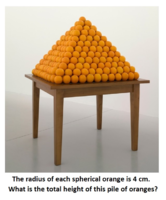Total height
- Thread starter Farzin
- Start date
- Joined
- Nov 24, 2012
- Messages
- 3,021
I would begin by finding the height h of a pyramid with a square base whose edges are all the same length s.
[MATH]h^2+\left(\frac{s}{2}\right)^2=\left(\frac{\sqrt{3}}{2}s\right)^2[/MATH]
[MATH]h=\frac{s}{\sqrt{2}}[/MATH]
Now, with s=22r and accounting for the 2r above and below, we have the height H of the pile of oranges:
[MATH]H=\frac{22r}{\sqrt{2}}+2r=(11\sqrt{2}+2)r[/MATH]
With [MATH]r=4\text{ cm}[/MATH] we find:
[MATH]H=(11\sqrt{2}+2)(4\text{ cm})\approx70.22539674441619\text{ cm}[/MATH]
[MATH]h^2+\left(\frac{s}{2}\right)^2=\left(\frac{\sqrt{3}}{2}s\right)^2[/MATH]
[MATH]h=\frac{s}{\sqrt{2}}[/MATH]
Now, with s=22r and accounting for the 2r above and below, we have the height H of the pile of oranges:
[MATH]H=\frac{22r}{\sqrt{2}}+2r=(11\sqrt{2}+2)r[/MATH]
With [MATH]r=4\text{ cm}[/MATH] we find:
[MATH]H=(11\sqrt{2}+2)(4\text{ cm})\approx70.22539674441619\text{ cm}[/MATH]
Excellent. ??I would begin by finding the height h of a pyramid with a square base whose edges are all the same length s.
[MATH]h^2+\left(\frac{s}{2}\right)^2=\left(\frac{\sqrt{3}}{2}s\right)^2[/MATH]
[MATH]h=\frac{s}{\sqrt{2}}[/MATH]
Now, with s=22r and accounting for the 2r above and below, we have the height H of the pile of oranges:
[MATH]H=\frac{22r}{\sqrt{2}}+2r=(11\sqrt{2}+2)r[/MATH]
With [MATH]r=4\text{ cm}[/MATH] we find:
[MATH]H=(11\sqrt{2}+2)(4\text{ cm})\approx70.22539674441619\text{ cm}[/MATH]
Nice job, well done. ??I got 8+44√2

